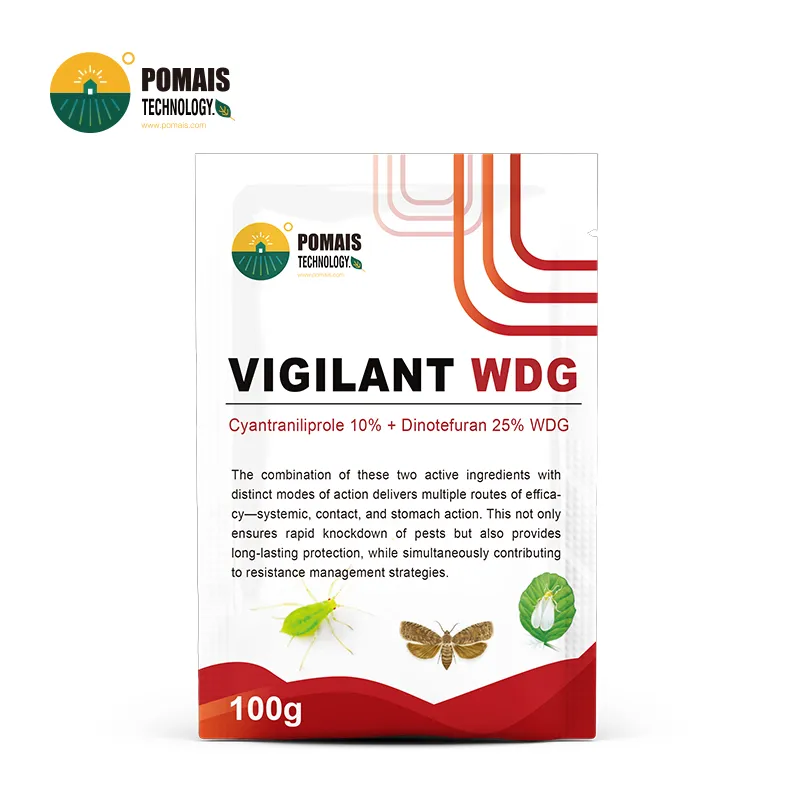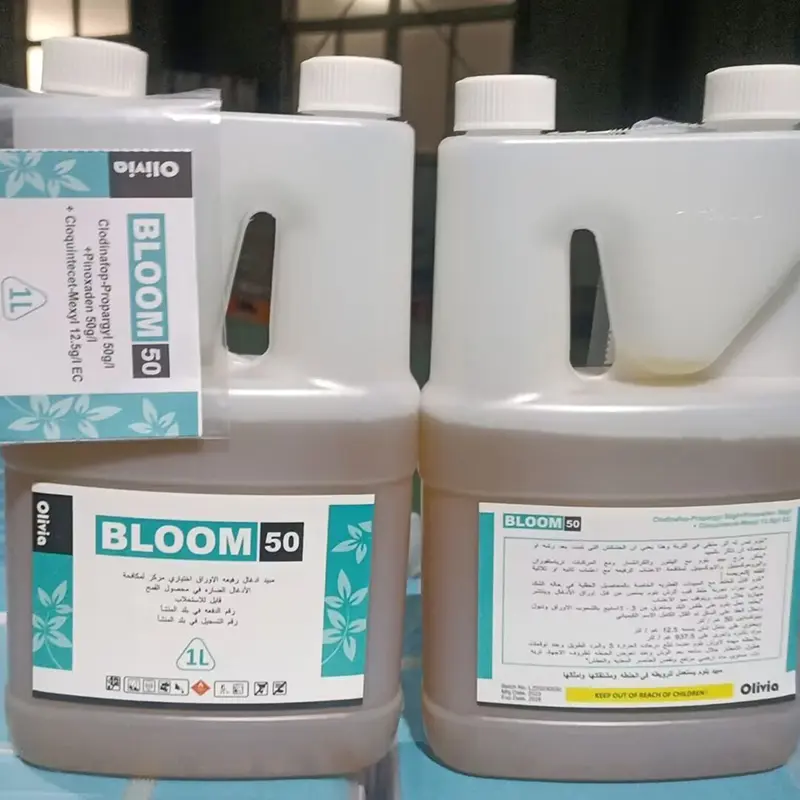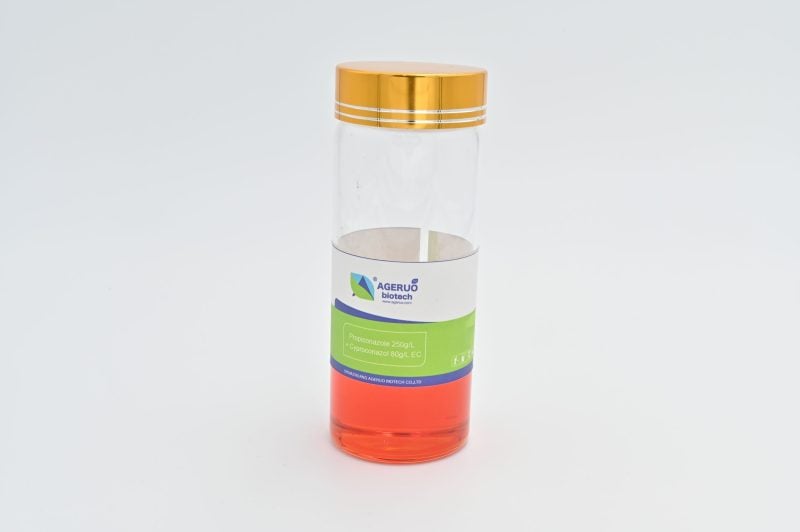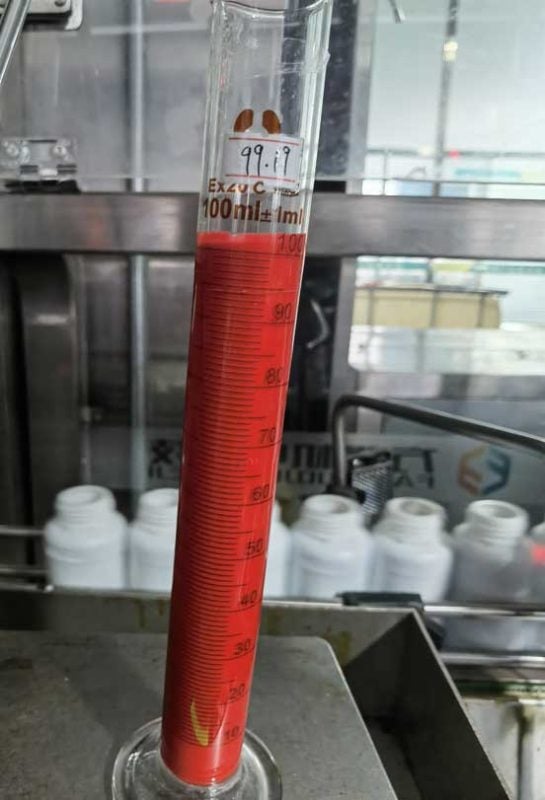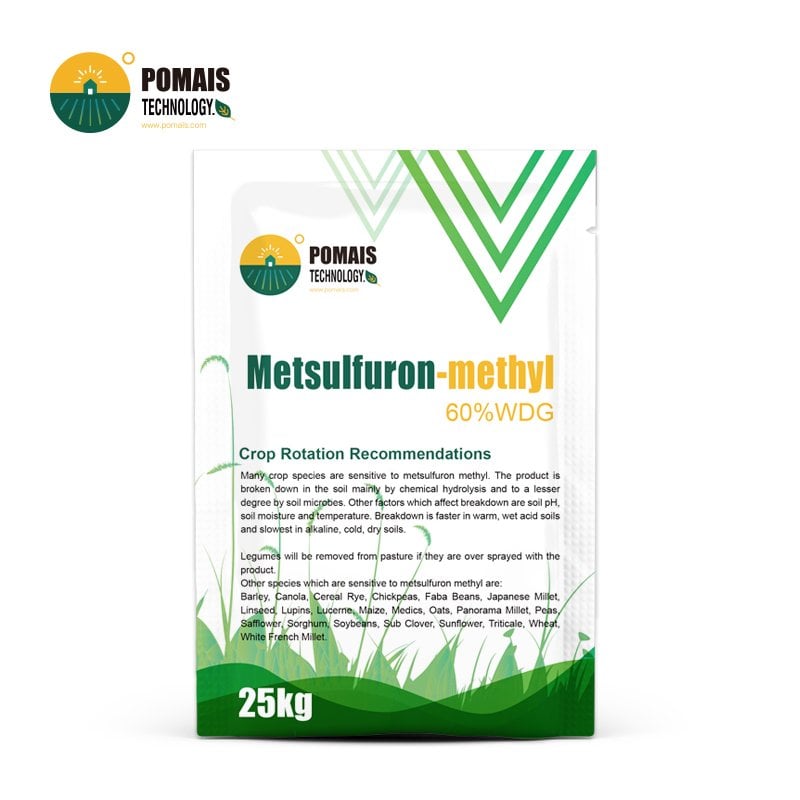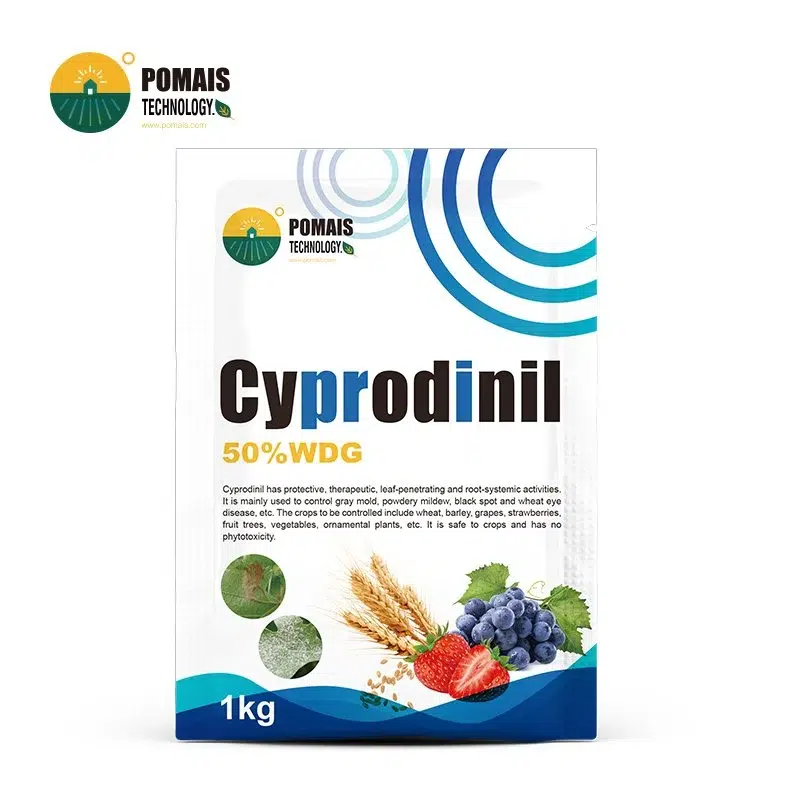Cyantraniliprole 10% + Dinotefuran 25% WDG
Cyantraniliprole 10% + Dinotefuran 25% WDG is a fixed-ratio, water-dispersible granule combining an anthranilic diamide (IRAC 28) with a neonicotinoid (IRAC 4A). You deploy Cyantraniliprole 10% + Dinotefuran 25% WDG when you need rapid knockdown of sap-feeding pests (aphids, whiteflies, planthoppers) together with residual protection against chewing larvae (armyworms, leafrollers) in registered crops and protected cultivation. The 10% + 25% balance delivers fast onset from dinotefuran and sustained coverage from cyantraniliprole, while WDG handling ensures low dust, quick wetting, and stable suspension for consistent spraying. Use patterns, target spectrum, and PHIs depend on the approved label in your market. Always follow the product label and local regulations; do not apply off-label or rely on generalized rates.
- Designed for Professional Buyers & Bulk Orders
- This product is available for business purchase and large-scale distribution.
- We support custom packaging, labeling, and formulation to meet your market needs.
- Let’s build your brand together.

About Cyantraniliprole 10% + Dinotefuran 25% WDG
About Cyantraniliprole 10% + Dinotefuran 25% WDG
| Product | Cyantraniliprole 10% + Dinotefuran 25% WDG |
| Content | Cyantraniliprole 10% (IRAC 28) + Dinotefuran 25% (IRAC 4A) |
| Formulation | WDG (water-dispersible granule) |
| Positioning | Fast knockdown + residual control, where registered |
| Target Pests* | Sap-feeders (aphids, whiteflies, planthoppers) + chewing larvae (armyworms, cutworms, leafrollers) |
| Crop Segments* | Field crops, vegetables, orchards, protected cultivation |
| Packaging | Foil sachets / laminated pouches / HDPE or PET bottles(sizes per market) |
| Documents | COA, SDS, TDS per lot |
| OEM/Private Label | Multilingual labels & custom packs |
| Compliance | Uses and intervals as per local approved label |
Cyantraniliprole 10% + Dinotefuran 25% WDG
Cyantraniliprole 10% + Dinotefuran 25% WDG is a fixed-ratio water-dispersible granule that combines an anthranilic diamide (cyantraniliprole, IRAC 28) at 10% with a neonicotinoid (dinotefuran, IRAC 4A) at 25%. You use this formulation when you need fast knockdown on sap-feeding pests together with residual protection against chewing larvae in a single pass. In practice, Cyantraniliprole 10% + Dinotefuran 25% WDG is typically positioned for commercial programs in field crops, vegetables, fruiting crops, and protected cultivation where it is registered. You can expect control of key piercing-sucking complexes (e.g., aphids, whiteflies, leafhoppers/planthoppers, certain thrips) and lepidopteran larvae (e.g., armyworms, cutworms, leafrollers), with spectrum and use patterns strictly determined by the approved product label in your market.
Operational advantages of the 10% + 25% WDG include low dusting, rapid wetting and dispersion, stable storage, and ease of handling across automated dosing or manual charging. Typical procurement focuses on batch-to-batch uniformity of granule size, dispersibility, and suspension quality to secure spray consistency at scale. Always follow the registered label and local regulations; do not rely on generalized rates or off-label guidance.
What Each Percentage Delivers: 10% Cyantraniliprole + 25% Dinotefuran
10% Cyantraniliprole — Residual Cover for Chewing Larvae (IRAC 28)
At 10%, cyantraniliprole provides the long-tail protection you need against chewing pests, especially lepidopteran larvae such as armyworms, cutworms, and leafrollers where the product is registered. By targeting ryanodine receptors, it disrupts muscle regulation and feeding, giving you sustained suppression after application. In commercial programs, this residual layer helps stabilize quality across scouting intervals, supports leaf area preservation, and maintains marketable yield potential. Because cyantraniliprole sits in IRAC Group 28, you can position it within rotations that alternate sites of action across the season to manage resistance pressure. Use conditions, crops, and PHIs must follow the approved label in your market.
25% Dinotefuran — Fast Systemic Knockdown for Sap-Feeders (IRAC 4A)
At 25%, dinotefuran delivers rapid, systemic activity against piercing-sucking complexes—aphids, whiteflies, planthoppers/leafhoppers, and certain thrips where registered. Acting on nicotinic acetylcholine receptors, it quickly curbs feeding, which is critical for minimizing honeydew, sooty mold, and virus transmission risk early in an outbreak. Its high water solubility supports swift plant uptake and even distribution, enabling you to restore crop appearance and marketability on a tight schedule. As an IRAC Group 4A component, dinotefuran should be rotated away from other 4A exposures according to label guidance to support stewardship.
In Cyantraniliprole 10% + Dinotefuran 25% WDG, you get a single formulation that pairs fast knockdown with durable residual—reducing repeat passes, simplifying SKUs, and aligning with procurement and quality-control requirements. Always follow the registered label and local regulations.
Mode of Action & Resistance Stewardship (IRAC 28 + 4A)
Outcome in one line: Fast systemic knockdown + residual feeding stop in one WDG, where registered.
How it works
- 10% Cyantraniliprole (IRAC 28)
- Targets ryanodine receptors; disrupts muscle control and feeding in chewing larvae.
- Delivers residual suppression of armyworms, cutworms, leafrollers.
- 25% Dinotefuran (IRAC 4A)
- Binds nicotinic acetylcholine receptors for rapid systemic knockdown in sap-feeders.
- Curbs feeding quickly; helps limit honeydew/sooty mold and early virus risk.
What you gain in programs
- One pass covers mixed pest complexes (sap-feeders + larvae).
- Stabilizes leaf area and quality between scouting intervals.
- WDG format supports clean metering and uniform suspension at scale.
Resistance stewardship (do this)
- Rotate MoA: alternate away from 4A and 28 on subsequent sprays per label.
- Sequence with different groups allowed by local labels(e.g., 3A, 5, 7, 9, 15, 22)。
- Avoid back-to-back exposures of the same MoA or repeating the same premix in a block.
- Base decisions on field scouting and thresholds; separate exposures across generations.
- Integrate non-chemical tactics(sanitation, host removal, canopy/irrigation management)。
- Keep equipment clean & calibrated to avoid sublethal dosing.
Crops, target pests, PHI and re-entry intervals are market-specific. Always follow the approved product label and local regulations.
Target Spectrum by Segment
Field Crops (rice, corn, cotton, soy, cereals)
Cyantraniliprole 10% + Dinotefuran 25% WDG is positioned for mixed complexes in broad-acre programs where registered. You target two blocks of pressure in one pass:
- Piercing–sucking pests (IRAC 4A action): aphids, whiteflies, planthoppers/leafhoppers, certain mirids and early thrips nymphs that drive honeydew, sooty mold, and virus risk.
- Chewing larvae (IRAC 28 action): armyworms, cutworms, leafrollers and other foliage-feeding larvae that erode canopy and grain fill.
Program notes: Deploy after scouting confirms early activity or in windows historically prone to outbreaks; alternate away from 4A/28 in subsequent sprays per label. Fit is strongest where sap-feeder surges coincide with larval waves and you need fast knockdown plus residual coverage. Final crop/pest claims follow the approved local label.
Vegetables & Horticulture (tomato, pepper, cucurbits, brassicas, leafy greens)
In intensive horticulture, Cyantraniliprole 10% + Dinotefuran 25% WDG addresses multi-pest dynamics that impact pack-out quality:
- Sap-feeders: aphids, whiteflies, leafhoppers/planthoppers, certain mealybug/psyllid pressures where permitted—priority is rapid feeding stop to protect fruit finish and reduce contamination risk.
- Larvae: leafrollers, armyworms, cutworms; plus leafminers in programs where the label covers them, contributing to cleaner foliage and marketable appearance.
Program notes: Use within IPM thresholds; rotate with non-4A/28 groups allowed on the crop. In high-value produce, the WDG format supports consistent suspensions through fine nozzles and enclosed sprayers. Observe PHI/REI as per the label; greenhouse vs open-field permissions differ by market.
Orchard & Protected Cultivation (citrus, pome/stone fruit, grapes; greenhouse veg & ornamentals)
Per registered uses, the premix supports quality preservation in perennial and protected systems:
- Sap-feeders: aphids, whiteflies, psyllids, leafhoppers/planthoppers, certain mealybugs—rapid systemic action limits honeydew/sooty mold and cosmetic downgrades.
- Larvae: leafrollers and other fruit- or leaf-feeding caterpillars where listed, helping maintain cover leaf integrity and finish.
Program notes: Time applications to pressure onsets and canopy density; integrate biological controls and cultural hygiene in protected houses. Rotate modes of action across generations; avoid back-to-back exposures of 4A or 28. Always follow the local product label for crops, pests, intervals, and any greenhouse-specific conditions.
Spectrum, crops, and intervals are label-dependent and may vary by country. Always follow the registered product label and local regulations.
Program Fit & Application Logic
Where It Fits in Your Season
You deploy Cyantraniliprole 10% + Dinotefuran 25% WDG when fields or houses face mixed pressure—sap-feeders building fast while chewing larvae begin to cut foliage—especially in crops and uses where the product is registered. Position it at the preventive to early-curative window: soon after scouting flags rising nymphal stages (aphids/whiteflies/planthoppers) or the first larval instars in lepidopterans. The 10% + 25% ratio gives you rapid feeding stop plus residual suppression, helping you stabilize quality between scouting rounds and reduce rescue sprays.
Decision Framework (no rates disclosed)
- Trigger: scouting thresholds, trap trends, and crop stage; prioritize young, actively feeding populations.
- Rotation: alternate away from IRAC 4A/28 in subsequent sprays as labels permit; avoid back-to-back exposures of the same MoA.
- Sequence: use in programs that bridge early sap-feeder spikes and the following larval wave; follow with a different MoA if pressure persists.
- Protected vs Open Field: in greenhouses, align with biologicals and sanitation; in open field, coordinate with canopy and irrigation management.
- Quality Objectives: protect leaf area, finish, and pack-out standards while maintaining compliant PHI/REI.
Tank-Mix & Compatibility Principles
Use only where labels allow. Conduct a jar test for new partners; load and agitation per best practice. Align adjuvant choices with target pests, canopy, and water quality guidance on local labels. Keep systems clean and calibrated to prevent under-dosing and performance variance. Observe any label-listed restrictions for sensitive crops or varieties.
Crops, target pests, intervals, and application limits vary by country. Always follow the approved product label and local regulations.
Selectivity & Environmental Notes
Crop Selectivity
Cyantraniliprole 10% + Dinotefuran 25% WDG is selective to label-approved crops when used as directed. You should verify variety sensitivity in a small block before full-scale use, especially in stress conditions (heat, drought, salinity) or after other chemistries. Canopy density, waxiness, and growth stage influence visible effects; align timing to minimize cosmetic impact and protect marketable finish. Do not apply to non-listed crops or use off-label sequences.
Beneficials & Pollinators
Because the premix contains a 4A component, manage exposure to bees and bumblebees in open fields and protected houses. Apply when pollinators are not foraging and avoid direct spray to blooming plants or extra-floral nectaries as per your local label. Integrate biological controls and monitoring to limit unnecessary sprays and preserve beneficial arthropods. Rotate away from 4A/28 to sustain IPM performance.
Environmental Stewardship
Follow label-specified buffer zones near waterways, manage drift with appropriate droplet size and boom height, and schedule applications to avoid runoff events. Prepare and dispose of rinsates and containers according to local regulations; never discharge into drains or natural water bodies. Use only clean water sources and maintain agitation for a stable suspension; incompatible water or residues can cause flakes and uneven delivery.
Worker Safety & Compliance
Mix/load and apply with the PPE required on the approved label. Observe REI/PHI as specified for your market and crop. Keep equipment calibrated to prevent under-dosing and resistance selection. For export-oriented growers, confirm destination MRL requirements before scheduling sprays. Always follow the registered product label and local regulations.
Packaging, OEM & Registration Support
Pack Formats for Cyantraniliprole 10% + Dinotefuran 25% WDG
You can configure moisture-tight retail and bulk packs to match route-to-market and label rules. Common options include aluminum-foil sachets, laminated pouches, HDPE/PET bottles with induction seals, and water-soluble inner bags for closed-system charging where permitted. Outer cartons use export-grade board with liner protection and palletization schemes sized for container loading. All packs are engineered for dry-room filling, low dust, and stable pourability across shelf life. If your market requires child-resistant features or tamper evidence, these can be specified at the dieline stage. Final pack sizes, warning statements, and transport marks remain subject to local registration and hazard classification.
Private Label & Artwork
You receive end-to-end private-label support: bilingual/multilingual label sets (Arabic, French, Spanish, Russian, Portuguese, and others), barcode and serialization fields, variable QR codes for digital leaflets, and compliant pictograms. We align artwork with your brand system (color, typography, iconography) while preserving mandatory statements, precautionary phrases, and application directions from the approved label. Bottle shapes, caps, scoops, and measuring aids are configurable to your handling SOPs. Master data (SKU codes, inner/outer dimensions, net/gross weights) is supplied for your ERP onboarding.
Documentation & Registration Enablement
Each batch ships with a full COA, MSDS/SDS, and TDS. Registration packs include typical dossiers: formulation composition ranges, manufacturing flow, in-process controls, finished-product specs (assay by HPLC, suspensibility, wetting time, foam, attrition, particle-size distribution), stability summaries (accelerated and long-term), packaging compatibility notes, and retention-sample policy. Where applicable, we provide label drafts, mockups, and carton markings tailored to your authority templates. All claims, crops, target pests, PHI/REI, and transport classes are finalized against the approved product label and local regulations before print release.
Quality & Supply Assurance
Manufacturing & In-Process Controls
Cyantraniliprole 10% + Dinotefuran 25% WDG is produced under an ISO-managed quality system with validated granulation and drying steps. Raw materials are identity-tested and released against approved specs before batching. In-process controls monitor granule moisture, density, and a tight particle-size window to secure fast wetting and stable suspension across your spray fleet. Each batch is assigned a lot code for end-to-end traceability from API to finished pack.
Finished-Product Specifications We Verify
Every production lot is tested against a registered specification set, including:
- Assay by HPLC for both actives (conformance to the 10% / 25% nominal claims).
- Suspensibility & wetting time to ensure rapid dispersion and uniform delivery.
- Foam behavior & pH to protect pump performance and coating quality.
- Attrition/fines & friability to reduce dusting and segregation in transport.
- Wet-sieve residue / PSD profile to support nozzle consistency and coverage.
Results are summarized on the COA supplied with each shipment; MSDS/SDS and TDS accompany your registration or onboarding pack.
Stability, Retention & Packaging Integrity
Accelerated and real-time stability programs confirm content uniformity, dispersibility, and package integrity through shelf life. Retention samples are archived per lot for post-market inquiries. Moisture-barrier packaging, induction seals, and tamper-evidence options are qualified to maintain granule flow and prevent caking under typical distribution climates.
Supply Continuity & Service Levels
Forecast-based production planning supports steady availability for seasonal peaks. We offer configurable pack sizes and multi-language labels under private label. MOQ, lead time, and palletization schemes are aligned at PO to match your route-to-market and regulatory timelines. All shipments include batch documents and traceability data to streamline your QA release.
Specifications, labeling, transport class, and shelf-life statements are finalized against the approved product label and local regulations in your market.
FAQ — Cyantraniliprole 10% + Dinotefuran 25% WDG
Q1. What insect groups does this formulation target?
You use Cyantraniliprole 10% + Dinotefuran 25% WDG where labels permit control of mixed complexes: piercing–sucking pests (aphids, whiteflies, planthoppers/leafhoppers, certain thrips/mealybugs/psyllids) and chewing larvae (armyworms, cutworms, leafrollers). Final claims are crop- and market-specific; follow the approved label.
Q2. How is this different from single-active options?
The 25% dinotefuran (IRAC 4A) component delivers fast, systemic knockdown in sap-feeders, while 10% cyantraniliprole (IRAC 28) provides residual suppression in chewing larvae. In one pass, you cover two pressure types and simplify SKU management, then rotate to non-4A/28 groups per label.
Q3. Can I use it in greenhouses and open fields?
Yes, where registered. Permissions, PHI/REI, ventilation rules, and beneficials/pollinator precautions may differ between protected and open systems. Check the local label for house-specific instructions before scheduling sprays.
Q4. What about tank mixing and compatibility?
Use only where allowed. Perform a jar test for any new partner, align water quality and adjuvant choices with label guidance, and maintain agitation. Avoid stacking the same MoA in sequence; build rotations outside 4A/28 as labels permit.
Q5. How should I think about residues and export markets?
Plan around PHI/REI on your local label and verify destination-market MRLs before harvest. Coordinate with buyers on cut-off dates and keep batch documents (COA, SDS, TDS) for audits.
Q6. What storage and handling conditions are recommended?
Keep packs sealed, dry, and out of temperature extremes. The WDG is designed for low dust, quick wetting, and stable suspension when handled as directed. Use moisture-barrier packaging; reseal opened units promptly.
Q7. How do I verify product quality on receipt?
Release lots ship with COA covering both assays (10%/25%), suspensibility/wetting time, PSD/fines, foam, and pH. Inspect tamper evidence, lot codes, and pack integrity; retain samples per your SOP for traceability.
Request a specification pack for Cyantraniliprole 10% + Dinotefuran 25% WDG including COA/SDS/TDS templates, stability summaries, and draft labels. We will provide packaging proposals (sachets, pouches, bottles, water-soluble inners), multilingual artwork, and an outline dossier to support local registration. Share your forecast, target crops, and label language—we will confirm MOQ, lead time, palletization, and supply a label mockup for your market. All product uses, crops, pests, and intervals remain subject to the approved label and local regulations.
| Product | Cyantraniliprole 10% + Dinotefuran 25% WDG |
| Content | Cyantraniliprole 10% (IRAC 28) + Dinotefuran 25% (IRAC 4A) |
| Formulation | WDG (water-dispersible granule) |
| Positioning | Fast knockdown + residual control, where registered |
| Target Pests* | Sap-feeders (aphids, whiteflies, planthoppers) + chewing larvae (armyworms, cutworms, leafrollers) |
| Crop Segments* | Field crops, vegetables, orchards, protected cultivation |
| Packaging | Foil sachets / laminated pouches / HDPE or PET bottles(sizes per market) |
| Documents | COA, SDS, TDS per lot |
| OEM/Private Label | Multilingual labels & custom packs |
| Compliance | Uses and intervals as per local approved label |
Cyantraniliprole 10% + Dinotefuran 25% WDG
Cyantraniliprole 10% + Dinotefuran 25% WDG is a fixed-ratio water-dispersible granule that combines an anthranilic diamide (cyantraniliprole, IRAC 28) at 10% with a neonicotinoid (dinotefuran, IRAC 4A) at 25%. You use this formulation when you need fast knockdown on sap-feeding pests together with residual protection against chewing larvae in a single pass. In practice, Cyantraniliprole 10% + Dinotefuran 25% WDG is typically positioned for commercial programs in field crops, vegetables, fruiting crops, and protected cultivation where it is registered. You can expect control of key piercing-sucking complexes (e.g., aphids, whiteflies, leafhoppers/planthoppers, certain thrips) and lepidopteran larvae (e.g., armyworms, cutworms, leafrollers), with spectrum and use patterns strictly determined by the approved product label in your market.
Operational advantages of the 10% + 25% WDG include low dusting, rapid wetting and dispersion, stable storage, and ease of handling across automated dosing or manual charging. Typical procurement focuses on batch-to-batch uniformity of granule size, dispersibility, and suspension quality to secure spray consistency at scale. Always follow the registered label and local regulations; do not rely on generalized rates or off-label guidance.
What Each Percentage Delivers: 10% Cyantraniliprole + 25% Dinotefuran
10% Cyantraniliprole — Residual Cover for Chewing Larvae (IRAC 28)
At 10%, cyantraniliprole provides the long-tail protection you need against chewing pests, especially lepidopteran larvae such as armyworms, cutworms, and leafrollers where the product is registered. By targeting ryanodine receptors, it disrupts muscle regulation and feeding, giving you sustained suppression after application. In commercial programs, this residual layer helps stabilize quality across scouting intervals, supports leaf area preservation, and maintains marketable yield potential. Because cyantraniliprole sits in IRAC Group 28, you can position it within rotations that alternate sites of action across the season to manage resistance pressure. Use conditions, crops, and PHIs must follow the approved label in your market.
25% Dinotefuran — Fast Systemic Knockdown for Sap-Feeders (IRAC 4A)
At 25%, dinotefuran delivers rapid, systemic activity against piercing-sucking complexes—aphids, whiteflies, planthoppers/leafhoppers, and certain thrips where registered. Acting on nicotinic acetylcholine receptors, it quickly curbs feeding, which is critical for minimizing honeydew, sooty mold, and virus transmission risk early in an outbreak. Its high water solubility supports swift plant uptake and even distribution, enabling you to restore crop appearance and marketability on a tight schedule. As an IRAC Group 4A component, dinotefuran should be rotated away from other 4A exposures according to label guidance to support stewardship.
In Cyantraniliprole 10% + Dinotefuran 25% WDG, you get a single formulation that pairs fast knockdown with durable residual—reducing repeat passes, simplifying SKUs, and aligning with procurement and quality-control requirements. Always follow the registered label and local regulations.
Mode of Action & Resistance Stewardship (IRAC 28 + 4A)
Outcome in one line: Fast systemic knockdown + residual feeding stop in one WDG, where registered.
How it works
- 10% Cyantraniliprole (IRAC 28)
- Targets ryanodine receptors; disrupts muscle control and feeding in chewing larvae.
- Delivers residual suppression of armyworms, cutworms, leafrollers.
- 25% Dinotefuran (IRAC 4A)
- Binds nicotinic acetylcholine receptors for rapid systemic knockdown in sap-feeders.
- Curbs feeding quickly; helps limit honeydew/sooty mold and early virus risk.
What you gain in programs
- One pass covers mixed pest complexes (sap-feeders + larvae).
- Stabilizes leaf area and quality between scouting intervals.
- WDG format supports clean metering and uniform suspension at scale.
Resistance stewardship (do this)
- Rotate MoA: alternate away from 4A and 28 on subsequent sprays per label.
- Sequence with different groups allowed by local labels(e.g., 3A, 5, 7, 9, 15, 22)。
- Avoid back-to-back exposures of the same MoA or repeating the same premix in a block.
- Base decisions on field scouting and thresholds; separate exposures across generations.
- Integrate non-chemical tactics(sanitation, host removal, canopy/irrigation management)。
- Keep equipment clean & calibrated to avoid sublethal dosing.
Crops, target pests, PHI and re-entry intervals are market-specific. Always follow the approved product label and local regulations.
Target Spectrum by Segment
Field Crops (rice, corn, cotton, soy, cereals)
Cyantraniliprole 10% + Dinotefuran 25% WDG is positioned for mixed complexes in broad-acre programs where registered. You target two blocks of pressure in one pass:
- Piercing–sucking pests (IRAC 4A action): aphids, whiteflies, planthoppers/leafhoppers, certain mirids and early thrips nymphs that drive honeydew, sooty mold, and virus risk.
- Chewing larvae (IRAC 28 action): armyworms, cutworms, leafrollers and other foliage-feeding larvae that erode canopy and grain fill.
Program notes: Deploy after scouting confirms early activity or in windows historically prone to outbreaks; alternate away from 4A/28 in subsequent sprays per label. Fit is strongest where sap-feeder surges coincide with larval waves and you need fast knockdown plus residual coverage. Final crop/pest claims follow the approved local label.
Vegetables & Horticulture (tomato, pepper, cucurbits, brassicas, leafy greens)
In intensive horticulture, Cyantraniliprole 10% + Dinotefuran 25% WDG addresses multi-pest dynamics that impact pack-out quality:
- Sap-feeders: aphids, whiteflies, leafhoppers/planthoppers, certain mealybug/psyllid pressures where permitted—priority is rapid feeding stop to protect fruit finish and reduce contamination risk.
- Larvae: leafrollers, armyworms, cutworms; plus leafminers in programs where the label covers them, contributing to cleaner foliage and marketable appearance.
Program notes: Use within IPM thresholds; rotate with non-4A/28 groups allowed on the crop. In high-value produce, the WDG format supports consistent suspensions through fine nozzles and enclosed sprayers. Observe PHI/REI as per the label; greenhouse vs open-field permissions differ by market.
Orchard & Protected Cultivation (citrus, pome/stone fruit, grapes; greenhouse veg & ornamentals)
Per registered uses, the premix supports quality preservation in perennial and protected systems:
- Sap-feeders: aphids, whiteflies, psyllids, leafhoppers/planthoppers, certain mealybugs—rapid systemic action limits honeydew/sooty mold and cosmetic downgrades.
- Larvae: leafrollers and other fruit- or leaf-feeding caterpillars where listed, helping maintain cover leaf integrity and finish.
Program notes: Time applications to pressure onsets and canopy density; integrate biological controls and cultural hygiene in protected houses. Rotate modes of action across generations; avoid back-to-back exposures of 4A or 28. Always follow the local product label for crops, pests, intervals, and any greenhouse-specific conditions.
Spectrum, crops, and intervals are label-dependent and may vary by country. Always follow the registered product label and local regulations.
Program Fit & Application Logic
Where It Fits in Your Season
You deploy Cyantraniliprole 10% + Dinotefuran 25% WDG when fields or houses face mixed pressure—sap-feeders building fast while chewing larvae begin to cut foliage—especially in crops and uses where the product is registered. Position it at the preventive to early-curative window: soon after scouting flags rising nymphal stages (aphids/whiteflies/planthoppers) or the first larval instars in lepidopterans. The 10% + 25% ratio gives you rapid feeding stop plus residual suppression, helping you stabilize quality between scouting rounds and reduce rescue sprays.
Decision Framework (no rates disclosed)
- Trigger: scouting thresholds, trap trends, and crop stage; prioritize young, actively feeding populations.
- Rotation: alternate away from IRAC 4A/28 in subsequent sprays as labels permit; avoid back-to-back exposures of the same MoA.
- Sequence: use in programs that bridge early sap-feeder spikes and the following larval wave; follow with a different MoA if pressure persists.
- Protected vs Open Field: in greenhouses, align with biologicals and sanitation; in open field, coordinate with canopy and irrigation management.
- Quality Objectives: protect leaf area, finish, and pack-out standards while maintaining compliant PHI/REI.
Tank-Mix & Compatibility Principles
Use only where labels allow. Conduct a jar test for new partners; load and agitation per best practice. Align adjuvant choices with target pests, canopy, and water quality guidance on local labels. Keep systems clean and calibrated to prevent under-dosing and performance variance. Observe any label-listed restrictions for sensitive crops or varieties.
Crops, target pests, intervals, and application limits vary by country. Always follow the approved product label and local regulations.
Selectivity & Environmental Notes
Crop Selectivity
Cyantraniliprole 10% + Dinotefuran 25% WDG is selective to label-approved crops when used as directed. You should verify variety sensitivity in a small block before full-scale use, especially in stress conditions (heat, drought, salinity) or after other chemistries. Canopy density, waxiness, and growth stage influence visible effects; align timing to minimize cosmetic impact and protect marketable finish. Do not apply to non-listed crops or use off-label sequences.
Beneficials & Pollinators
Because the premix contains a 4A component, manage exposure to bees and bumblebees in open fields and protected houses. Apply when pollinators are not foraging and avoid direct spray to blooming plants or extra-floral nectaries as per your local label. Integrate biological controls and monitoring to limit unnecessary sprays and preserve beneficial arthropods. Rotate away from 4A/28 to sustain IPM performance.
Environmental Stewardship
Follow label-specified buffer zones near waterways, manage drift with appropriate droplet size and boom height, and schedule applications to avoid runoff events. Prepare and dispose of rinsates and containers according to local regulations; never discharge into drains or natural water bodies. Use only clean water sources and maintain agitation for a stable suspension; incompatible water or residues can cause flakes and uneven delivery.
Worker Safety & Compliance
Mix/load and apply with the PPE required on the approved label. Observe REI/PHI as specified for your market and crop. Keep equipment calibrated to prevent under-dosing and resistance selection. For export-oriented growers, confirm destination MRL requirements before scheduling sprays. Always follow the registered product label and local regulations.
Packaging, OEM & Registration Support
Pack Formats for Cyantraniliprole 10% + Dinotefuran 25% WDG
You can configure moisture-tight retail and bulk packs to match route-to-market and label rules. Common options include aluminum-foil sachets, laminated pouches, HDPE/PET bottles with induction seals, and water-soluble inner bags for closed-system charging where permitted. Outer cartons use export-grade board with liner protection and palletization schemes sized for container loading. All packs are engineered for dry-room filling, low dust, and stable pourability across shelf life. If your market requires child-resistant features or tamper evidence, these can be specified at the dieline stage. Final pack sizes, warning statements, and transport marks remain subject to local registration and hazard classification.
Private Label & Artwork
You receive end-to-end private-label support: bilingual/multilingual label sets (Arabic, French, Spanish, Russian, Portuguese, and others), barcode and serialization fields, variable QR codes for digital leaflets, and compliant pictograms. We align artwork with your brand system (color, typography, iconography) while preserving mandatory statements, precautionary phrases, and application directions from the approved label. Bottle shapes, caps, scoops, and measuring aids are configurable to your handling SOPs. Master data (SKU codes, inner/outer dimensions, net/gross weights) is supplied for your ERP onboarding.
Documentation & Registration Enablement
Each batch ships with a full COA, MSDS/SDS, and TDS. Registration packs include typical dossiers: formulation composition ranges, manufacturing flow, in-process controls, finished-product specs (assay by HPLC, suspensibility, wetting time, foam, attrition, particle-size distribution), stability summaries (accelerated and long-term), packaging compatibility notes, and retention-sample policy. Where applicable, we provide label drafts, mockups, and carton markings tailored to your authority templates. All claims, crops, target pests, PHI/REI, and transport classes are finalized against the approved product label and local regulations before print release.
Quality & Supply Assurance
Manufacturing & In-Process Controls
Cyantraniliprole 10% + Dinotefuran 25% WDG is produced under an ISO-managed quality system with validated granulation and drying steps. Raw materials are identity-tested and released against approved specs before batching. In-process controls monitor granule moisture, density, and a tight particle-size window to secure fast wetting and stable suspension across your spray fleet. Each batch is assigned a lot code for end-to-end traceability from API to finished pack.
Finished-Product Specifications We Verify
Every production lot is tested against a registered specification set, including:
- Assay by HPLC for both actives (conformance to the 10% / 25% nominal claims).
- Suspensibility & wetting time to ensure rapid dispersion and uniform delivery.
- Foam behavior & pH to protect pump performance and coating quality.
- Attrition/fines & friability to reduce dusting and segregation in transport.
- Wet-sieve residue / PSD profile to support nozzle consistency and coverage.
Results are summarized on the COA supplied with each shipment; MSDS/SDS and TDS accompany your registration or onboarding pack.
Stability, Retention & Packaging Integrity
Accelerated and real-time stability programs confirm content uniformity, dispersibility, and package integrity through shelf life. Retention samples are archived per lot for post-market inquiries. Moisture-barrier packaging, induction seals, and tamper-evidence options are qualified to maintain granule flow and prevent caking under typical distribution climates.
Supply Continuity & Service Levels
Forecast-based production planning supports steady availability for seasonal peaks. We offer configurable pack sizes and multi-language labels under private label. MOQ, lead time, and palletization schemes are aligned at PO to match your route-to-market and regulatory timelines. All shipments include batch documents and traceability data to streamline your QA release.
Specifications, labeling, transport class, and shelf-life statements are finalized against the approved product label and local regulations in your market.
FAQ — Cyantraniliprole 10% + Dinotefuran 25% WDG
Q1. What insect groups does this formulation target?
You use Cyantraniliprole 10% + Dinotefuran 25% WDG where labels permit control of mixed complexes: piercing–sucking pests (aphids, whiteflies, planthoppers/leafhoppers, certain thrips/mealybugs/psyllids) and chewing larvae (armyworms, cutworms, leafrollers). Final claims are crop- and market-specific; follow the approved label.
Q2. How is this different from single-active options?
The 25% dinotefuran (IRAC 4A) component delivers fast, systemic knockdown in sap-feeders, while 10% cyantraniliprole (IRAC 28) provides residual suppression in chewing larvae. In one pass, you cover two pressure types and simplify SKU management, then rotate to non-4A/28 groups per label.
Q3. Can I use it in greenhouses and open fields?
Yes, where registered. Permissions, PHI/REI, ventilation rules, and beneficials/pollinator precautions may differ between protected and open systems. Check the local label for house-specific instructions before scheduling sprays.
Q4. What about tank mixing and compatibility?
Use only where allowed. Perform a jar test for any new partner, align water quality and adjuvant choices with label guidance, and maintain agitation. Avoid stacking the same MoA in sequence; build rotations outside 4A/28 as labels permit.
Q5. How should I think about residues and export markets?
Plan around PHI/REI on your local label and verify destination-market MRLs before harvest. Coordinate with buyers on cut-off dates and keep batch documents (COA, SDS, TDS) for audits.
Q6. What storage and handling conditions are recommended?
Keep packs sealed, dry, and out of temperature extremes. The WDG is designed for low dust, quick wetting, and stable suspension when handled as directed. Use moisture-barrier packaging; reseal opened units promptly.
Q7. How do I verify product quality on receipt?
Release lots ship with COA covering both assays (10%/25%), suspensibility/wetting time, PSD/fines, foam, and pH. Inspect tamper evidence, lot codes, and pack integrity; retain samples per your SOP for traceability.
Request a specification pack for Cyantraniliprole 10% + Dinotefuran 25% WDG including COA/SDS/TDS templates, stability summaries, and draft labels. We will provide packaging proposals (sachets, pouches, bottles, water-soluble inners), multilingual artwork, and an outline dossier to support local registration. Share your forecast, target crops, and label language—we will confirm MOQ, lead time, palletization, and supply a label mockup for your market. All product uses, crops, pests, and intervals remain subject to the approved label and local regulations.
Related Products
Latest News

